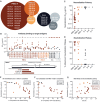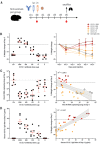Isolation of potent SARS-CoV-2 neutralizing antibodies and protection from disease in a small animal model
- PMID: 32540903
- PMCID: PMC7299280
- DOI: 10.1126/science.abc7520
Isolation of potent SARS-CoV-2 neutralizing antibodies and protection from disease in a small animal model
Abstract
Countermeasures to prevent and treat coronavirus disease 2019 (COVID-19) are a global health priority. We enrolled a cohort of severe acute respiratory syndrome coronavirus 2 (SARS-CoV-2)-recovered participants, developed neutralization assays to investigate antibody responses, adapted our high-throughput antibody generation pipeline to rapidly screen more than 1800 antibodies, and established an animal model to test protection. We isolated potent neutralizing antibodies (nAbs) to two epitopes on the receptor binding domain (RBD) and to distinct non-RBD epitopes on the spike (S) protein. As indicated by maintained weight and low lung viral titers in treated animals, the passive transfer of a nAb provides protection against disease in high-dose SARS-CoV-2 challenge in Syrian hamsters. The study suggests a role for nAbs in prophylaxis, and potentially therapy, of COVID-19. The nAbs also define protective epitopes to guide vaccine design.
Copyright © 2020 The Authors, some rights reserved; exclusive licensee American Association for the Advancement of Science. No claim to original U.S. Government Works.
Figures





Update of
-
Rapid isolation of potent SARS-CoV-2 neutralizing antibodies and protection in a small animal model.bioRxiv [Preprint]. 2020 May 15:2020.05.11.088674. doi: 10.1101/2020.05.11.088674. bioRxiv. 2020. Update in: Science. 2020 Aug 21;369(6506):956-963. doi: 10.1126/science.abc7520. PMID: 32511387 Free PMC article. Updated. Preprint.
References
-
- Corti D., Misasi J., Mulangu S., Stanley D. A., Kanekiyo M., Wollen S., Ploquin A., Doria-Rose N. A., Staupe R. P., Bailey M., Shi W., Choe M., Marcus H., Thompson E. A., Cagigi A., Silacci C., Fernandez-Rodriguez B., Perez L., Sallusto F., Vanzetta F., Agatic G., Cameroni E., Kisalu N., Gordon I., Ledgerwood J. E., Mascola J. R., Graham B. S., Muyembe-Tamfun J.-J., Trefry J. C., Lanzavecchia A., Sullivan N. J., Protective monotherapy against lethal Ebola virus infection by a potently neutralizing antibody. Science 351, 1339–1342 (2016). 10.1126/science.aad5224 - DOI - PubMed
-
- Misasi J., Gilman M. S. A., Kanekiyo M., Gui M., Cagigi A., Mulangu S., Corti D., Ledgerwood J. E., Lanzavecchia A., Cunningham J., Muyembe-Tamfun J. J., Baxa U., Graham B. S., Xiang Y., Sullivan N. J., McLellan J. S., Structural and molecular basis for Ebola virus neutralization by protective human antibodies. Science 351, 1343–1346 (2016). 10.1126/science.aad6117 - DOI - PMC - PubMed
Publication types
MeSH terms
Substances
Grants and funding
LinkOut - more resources
Full Text Sources
Other Literature Sources
Molecular Biology Databases
Research Materials
Miscellaneous

